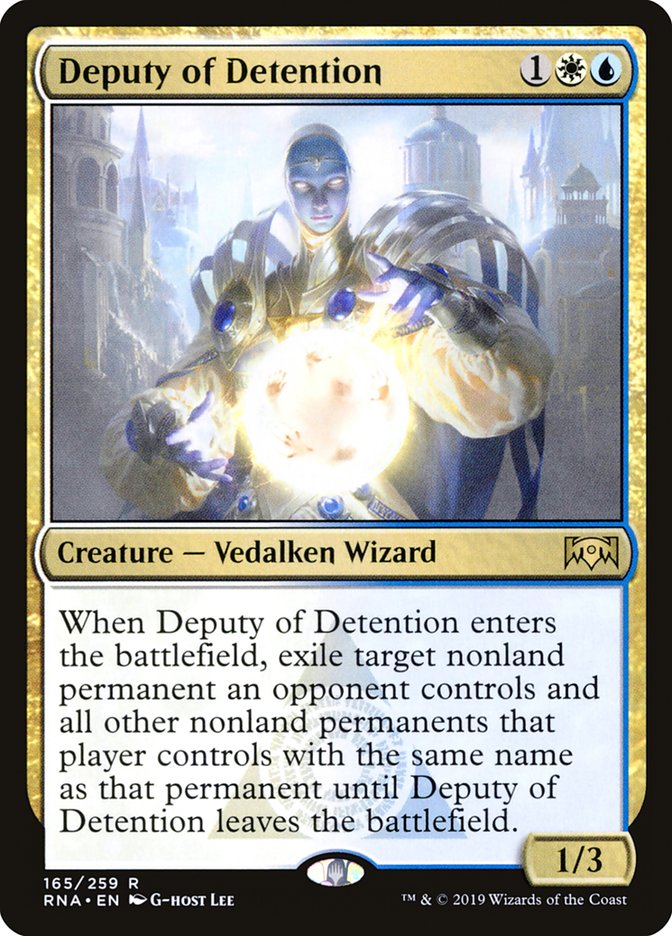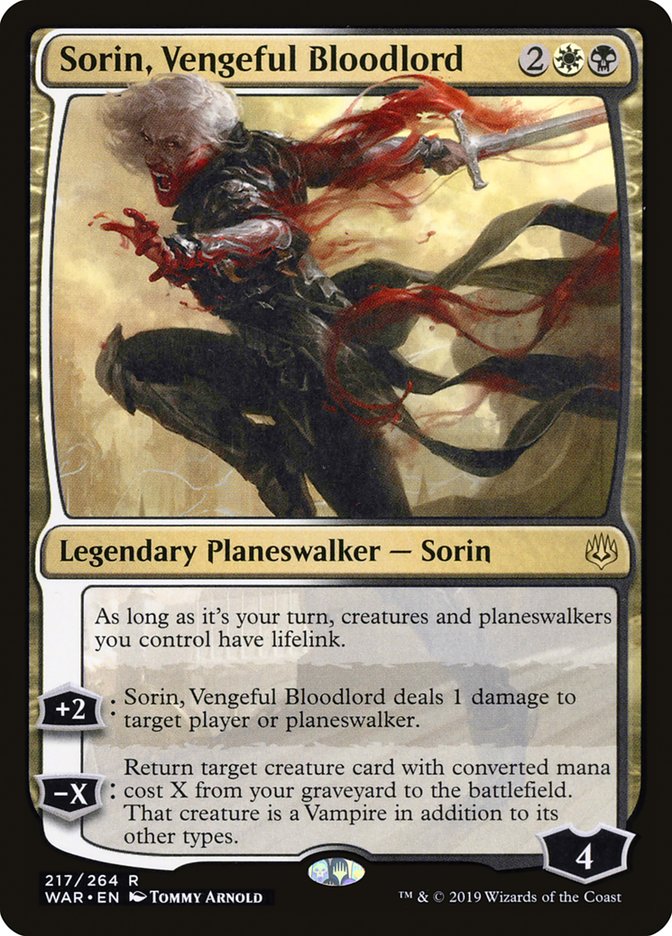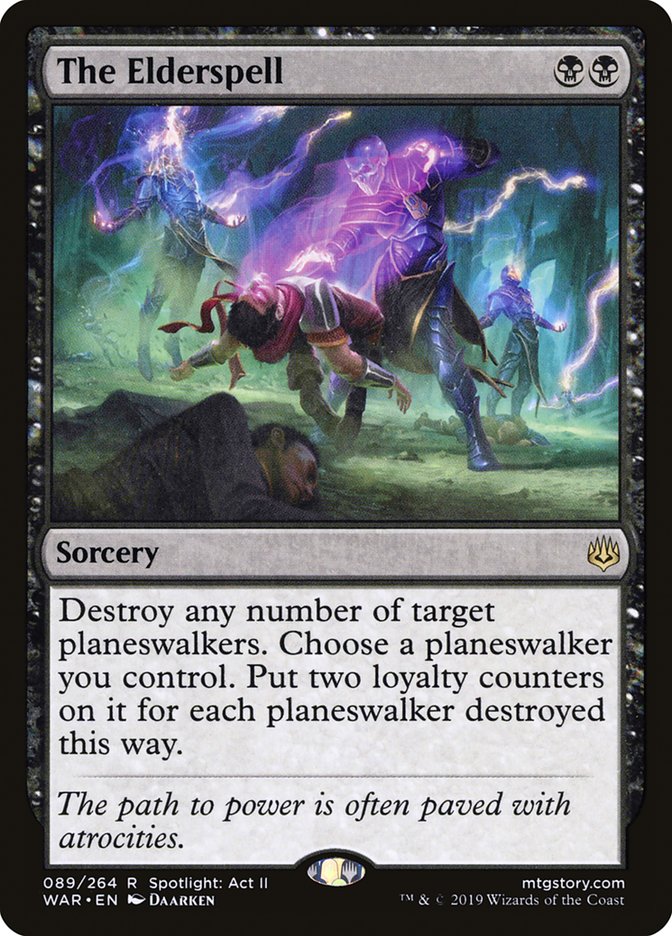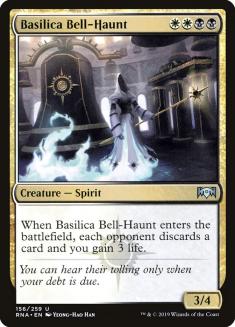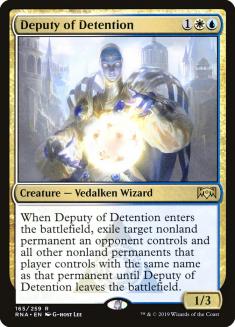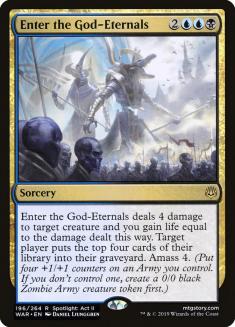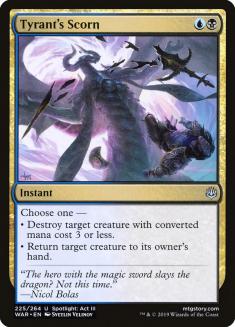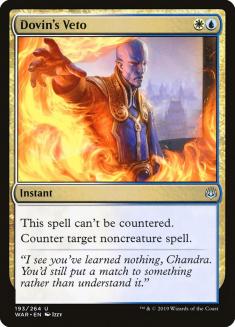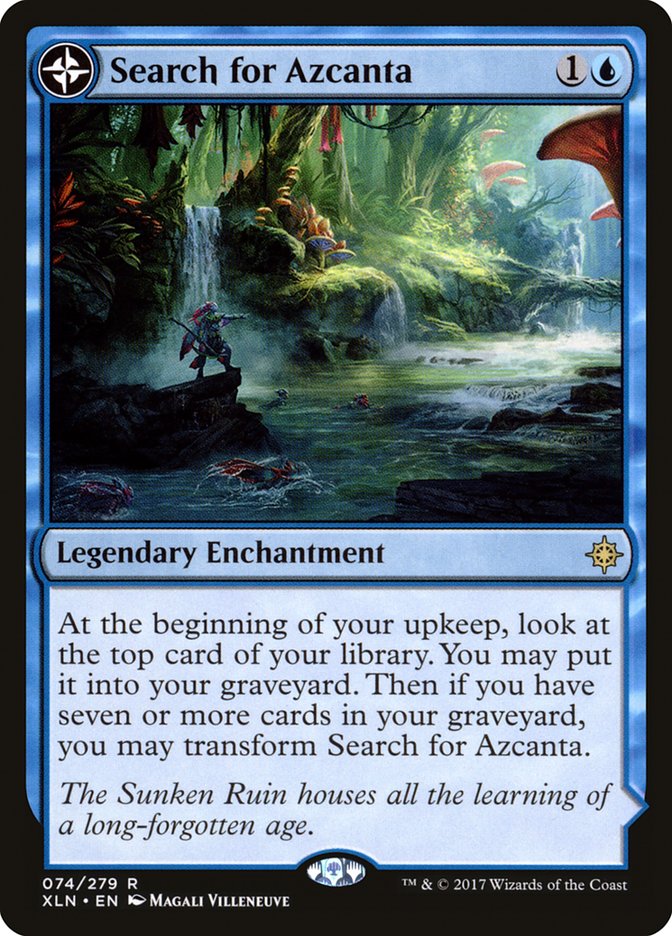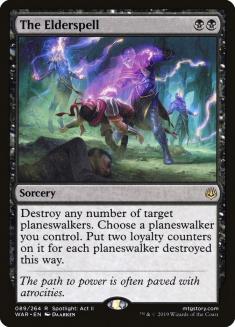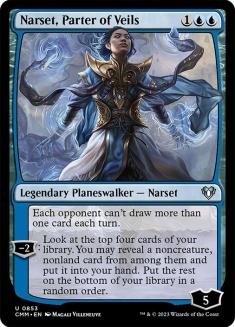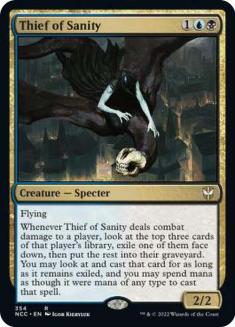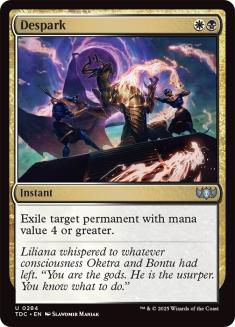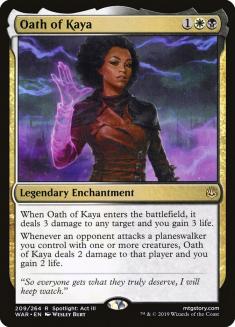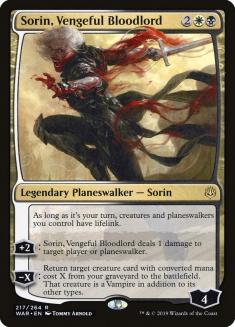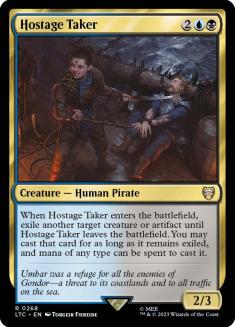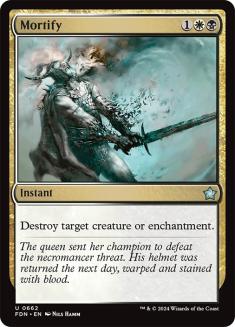Despite Esper Control receiving some of the top billing from SCG Richmond, Esper Midrange is the better deck, and it’s not particularly close.
Across the board, Esper Midrange has better matchups against Mono-Red Aggro, Simic Nexus, and green midrange decks. You suffer somewhat against Esper Control, at least in Game 1, and the white aggro decks are slightly worse than they would be with Esper Control, but Esper Midrange is also fundamentally stronger.
Keep in mind that last weekend, Esper Midrange decklists were all over the place. They didn’t know what to expect or what they needed to prepare to beat. Now that that’s out of the way, we can truly build a monster. Why do I believe we can actually do that?
The secret is that Esper Midrange is G/W Tokens in disguise. To get a better idea of why that’s relevant, you should read some of my articles on that deck if you haven’t already. The play patterns are remarkably similar and the overall strategy for both archetypes is exactly the same.
Creatures (14)
Planeswalkers (8)
Lands (26)
Spells (12)

In order for that sort of deck to work, it needs to be able to never run out of gas. You continue pushing your advantage, accruing value, and eventually win the game. I’m important to not spew resources if you can help it and to not take aggressive lines unless you know they will translate directly into a win or unless you have no other options. Slowly cut off your opponent’s outs by developing different threats and eventually you’ll bury your opponent.
With all the planeswalkers in the format, traction is incredibly important, which is one of the reasons I value having creatures in my deck. Good, cheap threats are particularly strong against the various three-mana planeswalkers, whereas Esper Control has to Vraska’s Contempt them or fight through them with their own card advantage. Overall, it’s a tall order. As always, I’d prefer to be more proactive.
I started working on Esper Midrange because I didn’t see a world where Absorb was a playable Magic card in the face of all the Teferi, Time Ravelers, and I’m glad I did. After a week of testing and tuning, I can share this beast in time for SCG Syracuse.
Creatures (14)
Planeswalkers (9)
Lands (25)
Spells (12)

While Esper Midrange certainly got a host of new toys from the last two sets, the real gain is being able to drop cards like Discovery and Seraph of the Scales for stronger options. Now, instead of having to stretch for options to make Hero of Precinct One good, we get to play a strong deck mostly comprised of cards we’d want to play anyway. There’s very little sacrificing for Hero going on.
Playing a host of planeswalkers is important for this type of deck to succeed. The fact that both Teferis and Sorin, Vengeful Bloodlord are defensive, help you stabilize, and help you pull ahead is what makes this sort of deck work.
Narset, Parter of Veils is the planeswalker getting the most hype at the moment, and although it’s well-earned, Narset doesn’t fit the maindeck of this deck because it lacks those defensive elements. There are very few cards that are stronger against opposing control decks, which is another good reason to have creatures in your deck.
For the most part, people are sleeping on Deputy of Detention, but the interaction between it and Sorin, Vengeful Bloodlord is one of the main reasons why I think this deck is incredible. You can’t play three Sorins without maxing on Deputy of Detentions, and Sorin is surprisingly good against opposing planeswalkers. Having access to Sorin means they can’t play Teferi, Time Raveler or Ugin, the Ineffable and immediately minus them without losing them. That chip damage ends up mattering a lot more than you’d immediately think it does.
Sorin is a clean two-for-one and sometimes much more. You can cast him and immediately bring back a huge threat. If Sorin sticks around for another few turns, you’ll be able to run it back. The same is true of Teferi, Time Raveler, and this deck is quite good at protecting a planeswalker for a few turns. At that point, you get to use them again, which helps cement your advantage. The goal should be to get two cards from each of your planeswalkers.
Teferi, Hero of Dominaria at the top-end isn’t something I see in every list, nor is it something I see in large numbers. Originally, I didn’t want Teferis either. It seemed like Esper Midrange was about presenting threats and answers, eventually winning with the value gained from Hero of Precinct One, Thief of Sanity, or Seraph of the Scales.
Trying to beat someone to death with Seraph of the Scales has basically never worked and there might not be a more awkward card against Teferi, Time Raveler. Having a draw engine at the top-end is exactly what the deck wants, especially since Teferi can play defense if necessary. My main regret is not having enough things to do at instant speed to take advantage of the untap clause, but it’s not a deal-breaker.
You could, in theory, have more copies of Tyrant’s Scorn, Dovin’s Veto, or Despark in the maindeck to take advantage of Teferi, but you would be losing out in that exchange overall. Those cards are narrow and you can’t afford to draw too many of those effects in certain matchups. Dovin’s Veto might seem great against control (and if I expected more Simic Nexus in the upcoming weeks, I would probably maindeck some copies), but the secret is out on Teferi, Time Raveler. Having proactive discard spells is almost always better, at least at the moment.
You should absolutely be playing The Elderspell at the moment. There is no shortage of decks with multiple planeswalkers right now, and it’s the best reset button you could possibly hope for. If you have your own planeswalker, even one without an ultimate like Sorin or little Teferi, it’s still incredible. There has been no other card in my deck that has produced the same amount of immediate concessions as The Elderspell. If the format continues to look like this, I’d even consider going up to a second copy.
It’s worth noting that I don’t mulligan too aggressively with this deck outside of the Simic Nexus and Mono-Red Aggro matchups. Against almost anything else, you want each resource, so being down a card can be backbreaking. I wouldn’t advise snap-keeping every seven-card hand, but I’ve kept several five-land hands and felt like it was correct.
Many things about this deck are customizable. Cards like Duress, Despark, and Basilica Bell-Haunt ideally wouldn’t be in the maindeck, but that’s a product of the current metagame. Duress is rarely dead, at least in small numbers, but against the top tier of the metagame, like Mono-Red, Simic Nexus, and Esper Control, it’s great. If you want to be a little better-rounded against an unexpected metagame, you can certainly add more versatile cards into your maindeck, but I’d argue that Duress is exactly the type of card that’s great against random Standard decks.
With decks like these, it’s imperative that you have an actual plan when sideboarding. Against control, you become an aggro-control deck that is capable of going long with them. Against aggro, you have to become the control deck. With things like Simic Nexus, you have to apply pressure while disrupting them and not care about card advantage too much.
Thankfully, all of this is doable with Esper Midrange. Again, you can’t say the same for Esper Control.
VS Esper Control
Out:
In:
As I said earlier, this is the tough one because they’re the only deck that can go over the top of you, thanks to all of their front-loaded card advantage. You could sideboard Chemister’s Insight yourself to try to get on even footing, but I prefer Narset and Search for Azcanta instead.
VS Mono-Red Aggro
Out:
In:
Against Mono-Red, no matter which version of Esper you play, you need some amount of dedicated hate to get the matchup above 50%. Esper basically has the tools to make Mono-Red as favorable as you want to; it just depends on how much space you want to dedicate. Basilica Bell-Haunt isn’t a card I would ever touch if Mono-Red weren’t so prevalent. It’s a hammer against Mono-Red (at least in Game 1) and just passable against everything else.
Between Bell-Haunt, Enter the God-Eternals, and Oath of Kaya, you have enough lifegain to turn Mono-Red into a favorable matchup. Each copy of those cards you add will make your percentage go up dramatically. If you want to really hammer Mono-Red, it only takes a few additional slots. Maybe some of the extra Bell-Haunts in the sideboard could make their way maindeck.
VS Simic Nexus
Out:
In:
If you don’t have an early threat, Narset and Teferi can buy you a ton of time to find one. You should be able to stop their deck from working for a short amount of time, but eventually they’ll find Blast Zone, remove your planeswalkers, and start doing their thing. You must try to deal them twenty damage rather than trying to lock them out of the game.
How you sideboard here should vary. They could have copies of Biogenic Ooze or Carnage Tyrant, but thankfully you have some insulation against random creatures thanks to your own blockers and Thought Erasure. A Turn 2 Kraul Harpooner can make life awkward for your three-mana planeswalkers if you don’t have an answer, so be wary of that.
VS Mono-White Aggro/Azorius Aggro
Out:
In:
Kill their stuff, gain some life, and eventually go over the top of them.
VS Esper Midrange
Out:
In:
Spot removal is either huge for stopping Thief of Sanity or useless in the face of planeswalkers. Since their threats typically have a large impact on the game, I’d rather err on the side of too much removal rather than not enough, especially considering you want to be able to protect your planeswalkers. Thankfully, Deputy of Detention allows you to have sufficient answers for Thief of Sanity while not being a brick against other permanents.
VS Sultai / Bant Midrange
Out:
In:
The Bant decks seem scary, but they aren’t. In theory, they should be able to do the same thing as you, plus have Hydroid Krasis at the top-end, but the games don’t play out that way. Hero of Precinct One and Thought Erasure are the two key cards that Bant doesn’t have access to. Esper also has Teferi, Hero of Dominaria, spot removal, and Sorin, Vengeful Bloodlord to give you small edges. Outside of God-Eternal Oketra, Bant doesn’t have any hope.
Prepare for a war of attrition. I’d like Narset here too if she weren’t so easily attacked by random Mefolk Branchwalkers. Sultai Midrange has basically the same plan, but they are worse at it than Bant is, so I wouldn’t expect to see much of that deck going forward.
You can make Esper Midrange into whatever you want it to be. If I were playing in Syracuse this weekend, I would play the above list in a heartbeat, but you should use this article as a starting point. Tailor the deck to your needs and you will be greatly rewarded. Esper Control is also a great deck (and arguably the better deck in a vacuum), but in the context of the metagame, Esper Midrange is currently perfect.


